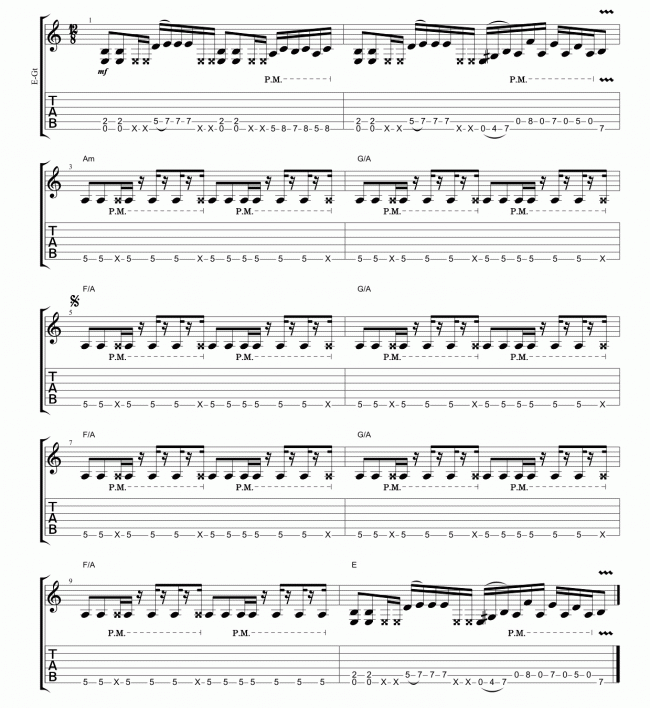
I was given the honour of interviewing one of my own main early influences Yngwie Malmsteen in July 2005 for Guitar Techniques magazine, along with my good friend Charlie Griffiths who was writing for Total Guitar magazine. We met up with Yngwie at a hotel in Kensington, London, and spent a couple of hours talking guitar, and filming some incredible ‘off-the-cuff’ improv over some backing tracks i’d prepared. Yngwie was lively and a pleasure to interview, and it was amazing seeing him for real demonstrating and playing through all the old classic riffs and licks, along with a breakdown of some of his techniques and approaches. One of the highlights was his spontaneous improv, which despite jet lag and general exhaustion from relentless travel and little sleep, he still played and performed with total energy and commitment, easily owning the tracks! Before we get to the transcriptions and free downloadable backing tracks, here is some history about this amazing neo-classical rock/metal virtuoso.
Yngwie Malmsteen was born in Stockholm, Sweden in June 1963 and started playing at the age of 7, inspired by the sight of Jimi Hendrix smashing and burning his guitar on a TV programme, as well as the impact of his death. His next main musical influence was listening to early Deep Purple albums…
 “When I was eight years old I was given Fireball by Deep Purple, and learned every Ritchie Blackmore solo on it. Every one!” says Yngwie. “In fact the very first thing I learned to play was blues. My mum had a Bluesbreakers album, which I loved and I still remember to this day,” Yngwie looks back.
“When I was eight years old I was given Fireball by Deep Purple, and learned every Ritchie Blackmore solo on it. Every one!” says Yngwie. “In fact the very first thing I learned to play was blues. My mum had a Bluesbreakers album, which I loved and I still remember to this day,” Yngwie looks back.
After an introduction to classical music through his sister, a passion developed for composers like Bach, Vivaldi, Beethoven and Mozart. The next turning point came a few years later when Yngwie saw a performance of Paganini’s 24 Caprices on TV..
“It completely blew my mind,” remembers Yngwie, “I knew there had to be more to guitar than what I was hearing before. When I heard those violin arpeggios I immediately tried to apply them to the guitar. I like to use three string arpeggios because they allow you to move around the neck quickly as well as providing a useful tool for learning where the root, 3rd and 5th intervals are in any key. When I put together an arpeggio piece, it starts when I hear the chord progression in my head and I then apply the arpeggios to the progression. I particularly like the sound of the diminished arpeggio as it sounds dramatic, which was the thing that attracted my ear to classical music originally.”
Yngwie would spend long hours during his teenage years working out licks and playing along, always recording each session for scrutiny later on.
“I always taped everything I played and when I listened back I would hear things I didn’t notice when I was playing. I would note what was good and what wasn’t and that’s how my style developed. I didn’t practise per se; I just played all day every day.”
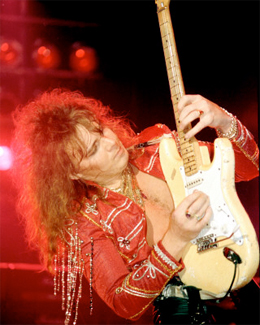 During his mid-teens, Yngwie’s trademark style was starting to emerge and by his late teens he was actively showcasing his new approach in bands and after sending demo tapes to record companies and contacts abroad, was brought to the U.S in 1982 by Mike Varney of Shrapnel Records. After recording for the debut self-titled Steeler album released in 1983, Yngwie joined Graham Bonnet’s Alcatrazz for the 1983 release No Parole from Rock’n’Roll and Live Sentence released in 1984.
During his mid-teens, Yngwie’s trademark style was starting to emerge and by his late teens he was actively showcasing his new approach in bands and after sending demo tapes to record companies and contacts abroad, was brought to the U.S in 1982 by Mike Varney of Shrapnel Records. After recording for the debut self-titled Steeler album released in 1983, Yngwie joined Graham Bonnet’s Alcatrazz for the 1983 release No Parole from Rock’n’Roll and Live Sentence released in 1984.
By the time Yngwie released his debut album Rising Force in 1984, his style combined the raw energy of his 1970‘s heavy blues-rock influences with the melodic and virtuosic aspects of the classical music he loved. Featuring ultra fast harmonic minor runs, sweep arpeggios and beautifully crafted instrumental arrangements, Yngwie took the guitar- playing world by storm with an array of refined techniques and a new classically influenced sound and was soon appearing in all the guitar magazines, claiming best new talent, and then best rock guitarist, while his debut was voted album of the year and went on to win a Grammy nomination for best rock instrumental performance! Neo-classical rock was born and the boundaries of the instrument were again pushed forward. Since that time, Yngwie has written over 20 albums showcasing his incredible style, including a Concerto Suite and is widely respected as one of the world’s most influential rock/metal players.
Solo 1
This solo starts in E Phrygian Dominant, which is the 5th mode in the key of A Harmonic Minor Scale. Here, Yngwie demonstrates his mastery in blending different techniques together, interchanging between alternate picking, sweep picking and legato effortlessly. Note that Yngwie rarely plays metronomically, preferring to phrase in odd groupings which creates a more flowing effect. Together with his mighty tone wide vibrato, the solo is infused with passion and energy.

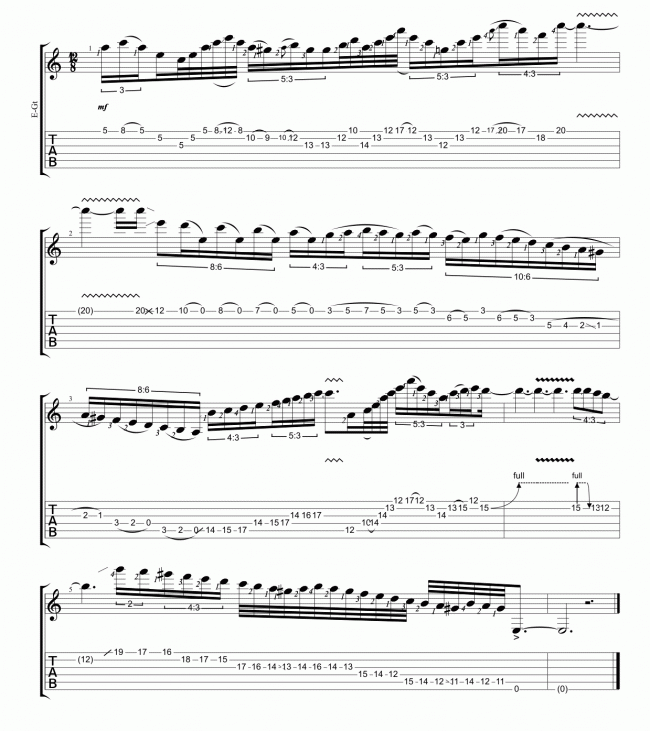
You can download the TABs for the solo (Guitar Pro and PDF format) at the bottom of the page.
The Solo 1 Backing Track starts with an Open E string riff based around E Phrygian Dominant, which is the 5th (V) mode of A Harmonic Minor. After a 4 bar intro, there’s a verse section with the riff settling into a groove, and with the introduction of the clean guitar playing an E open chord, moving the same open shape up a half-step to F and then up a whole step to G, leaving the low E string and high B and E strings droning. This is a great way to get the typical dark Phrygian Dominant sound (listen to the track Krakatau on the 1988 release Odyssey for example). After 12 bars of verse, the intro riff returns as a bridge for 4 bars, setting up a change to the A natural minor scale (Im or Aeolian / vi in C major if you prefer) and again a static bass groove underpinning a harmonic movement from Am (I), to G (VII), F (VI), and G (VII), and on the second time Am, G, F and E. (V borrowed from A Harmonic Minor). This arrangement then cycles round.
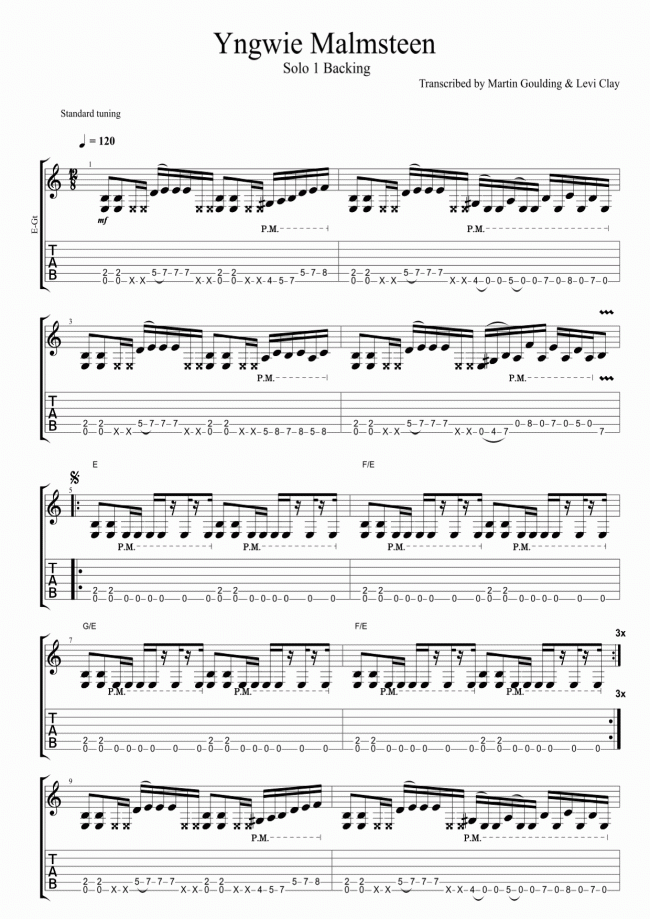
The backing track and it’s TAB are available in the download at the bottom of this page and has been transposed to standard pitch so no need to tune down to Eb.
Audio clip: Adobe Flash Player (version 9 or above) is required to play this audio clip. Download the latest version here. You also need to have JavaScript enabled in your browser.
The one overriding factor in Yngwie’s playing style is the sheer passion with which he delivers his ideas. “Remember it’s not just what you play, it’s the way that you play it.” Try to listen out for the tone-wide vibrato, a technique made easier by virtue of his scalloped fretboard. “I like my vibrato slow and wide. I first became aware of it whilst listening to Paganini. It adds emotion to the phrases.” says Yngwie.
Another often overlooked aspect of Yngwie’s style is his frequent use of the 5- way pickup selector switch. “At first I think I noticed Ritchie Blackmore doing it in the early days. I prefer the sound of arpeggios or fast scale runs with the neck pickup on and switch to the bridge pickup for the sustained notes. I don’t really think about it anymore as it’s now naturally ingrained.”
Solo 2
This next solo is played over a twelve bar progression in E and gives us an insight into Yngwie’s improvisational style. Starting with some E minor pentatonic ideas, Yngwie then develops into some rapid Dorian/Blues ideas, before a stunning chromatic descending pull-off lick. Work through this solo bar by bar in conjunction with the video and listen carefully to the end notes of the phrases where you will hear his characteristic tone-wide vibrato.

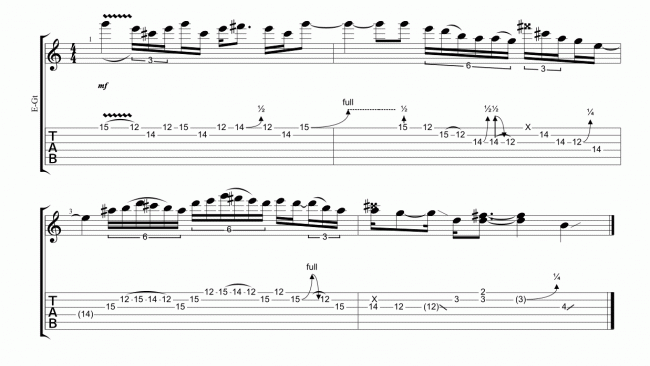
You can download the TABs for the solo (Guitar Pro and PDF format) at the bottom of the page.
The Solo 2 Backing Track is based around a Jimi Hendrix inspired vibe which Yngwie enjoys improvising over, often showcasing his hot rodded approach to bluesy playing with tunes like Spanish Castle Magic. The backing track has been transposed to standard pitch so no need to tune down to Eb. The TABs for this backing track as well as the Mp3 are in the download at the bottom of the page.
Audio clip: Adobe Flash Player (version 9 or above) is required to play this audio clip. Download the latest version here. You also need to have JavaScript enabled in your browser.
For more Yngwie Malmsteen influenced ideas, check out the sweeping section in my lesson area here, or visit my YouTube channel here to watch video lessons Yngwie’s amazing style.
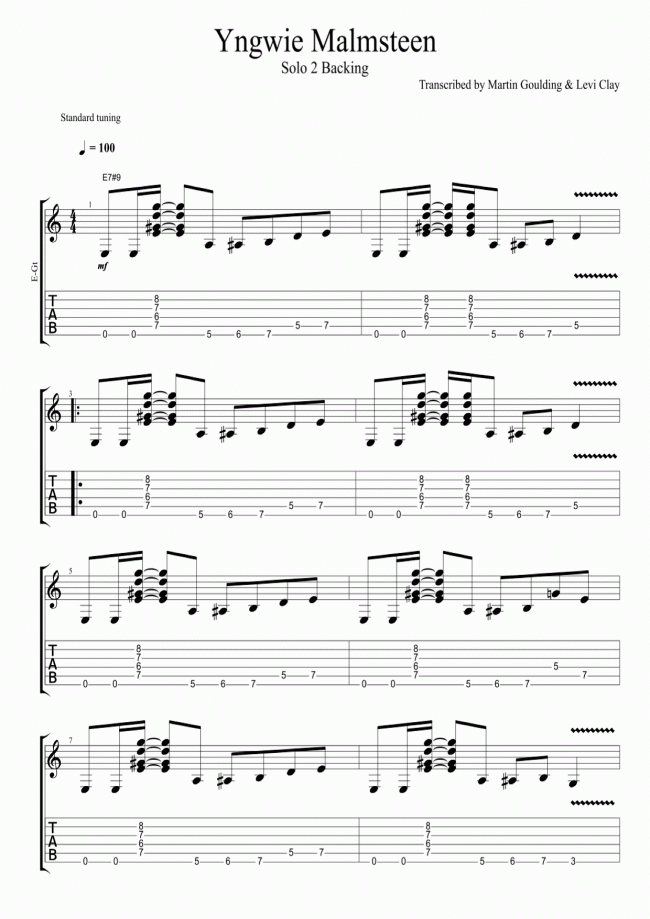

Download all the files (Mp3, Guitar Pro TAB’s and PDF format).
For more Yngwie Malmsteen influenced ideas, check out the sweeping section in my lesson area here, or visit my YouTube channel here to watch video lessons Yngwie’s amazing style.



